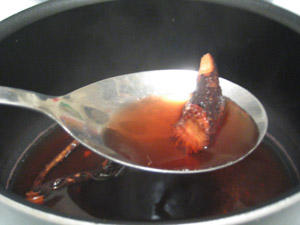Sweet Sassy Molassey!
We'll get to the fresh mozzarella in a minute, but first, I want to tell you what I know about root beer. It's delicious in a frosted mug on ice, or poured over vanilla ice cream for a float. But what is it? What is the "root" in root beer? The ingredients tell us nothing: corn syrup, "natural" and artificial flavorings, caramel color. As it turns out, the key is sassafras, the bark of the sassafras root, to be exact. It's worth noting that the root cannot be sold in the States for various reasons, the most likely being that the government cannot distinguish root beer makers from illicit drug makers.
That being said, sassafras is common along roads, meadows and water all through the eastern states. After having no luck in the local parks, I ended up in the Laurel Highlands of western Pennsylvania. It's beautiful country, plenty of forest, rivers, skiing, waterfalls and, finally, sassafras. It has distinctive
 leaves, and if that isn't enough, the root beer aroma when you scratch and sniff any part of the plant is a dead giveaway. I dug up a few saplings and chopped the roots off for my first attempt at root beer. Here's what I tried so far.
leaves, and if that isn't enough, the root beer aroma when you scratch and sniff any part of the plant is a dead giveaway. I dug up a few saplings and chopped the roots off for my first attempt at root beer. Here's what I tried so far.10 inches of skinny sassafras sapling root
2 cups water
1/2 tsp sugar
1/8 tsp molasses
1/8 tsp ground ginger
1/8 tsp vanilla extract
I boiled the root in the water for about 30 minutes. The two cups reduced to about 1/2 cup, and it was a nice reddish, fragrant liquor. To this I started adding the other ingredients, sampling the whole time, ending at the above amounts.
 Fresh ginger or some hops might be better than ground ginger, and the vanilla was a little overpowering. I found one recipe suggesting juniper berries and dandelion root. More roots, slower boil, and some new bitters for next time. I didn't have enough to bottle and carbonate, but when I do, I'll treat it like my homemade ginger beer, using a little yeast and a tight bottle.
Fresh ginger or some hops might be better than ground ginger, and the vanilla was a little overpowering. I found one recipe suggesting juniper berries and dandelion root. More roots, slower boil, and some new bitters for next time. I didn't have enough to bottle and carbonate, but when I do, I'll treat it like my homemade ginger beer, using a little yeast and a tight bottle.My first swing at mozzarella was a miss. Getting curds is the easy part, but having them acidic enough to "spin" into mozzarella is a little tougher than I thought. To half a gallon of whole milk over medium heat, I added 1/2 cup of lemon juice to curdle it. At about 100 degrees F (a little late) I added 1/2 tablet of rennet dissolved in 1/4 cup of water, and I got a bunch of big curds in whey. Pretty promising so far. I scooped out the curds at 105 degrees F, and set the whey to heat up to 175 with a little salt in.
This is where I should have paid better attention to all the warnings about mozzarella, because when I dripped my curds into the hot whey, they scattered and didn't really bother to spin, flip or cartwheel at all. The curds weren't too bad with a little salt. I heated up the whey to almost boiling, skimmed out the ricotta and had that for supper as well.
Next time I'll try adding a little cultured buttermilk to the milk and letting it develop acidity overnight. It has to happen soon - all those ripening tomatoes won't wait forever!

0 Comments:
Post a Comment
<< Home